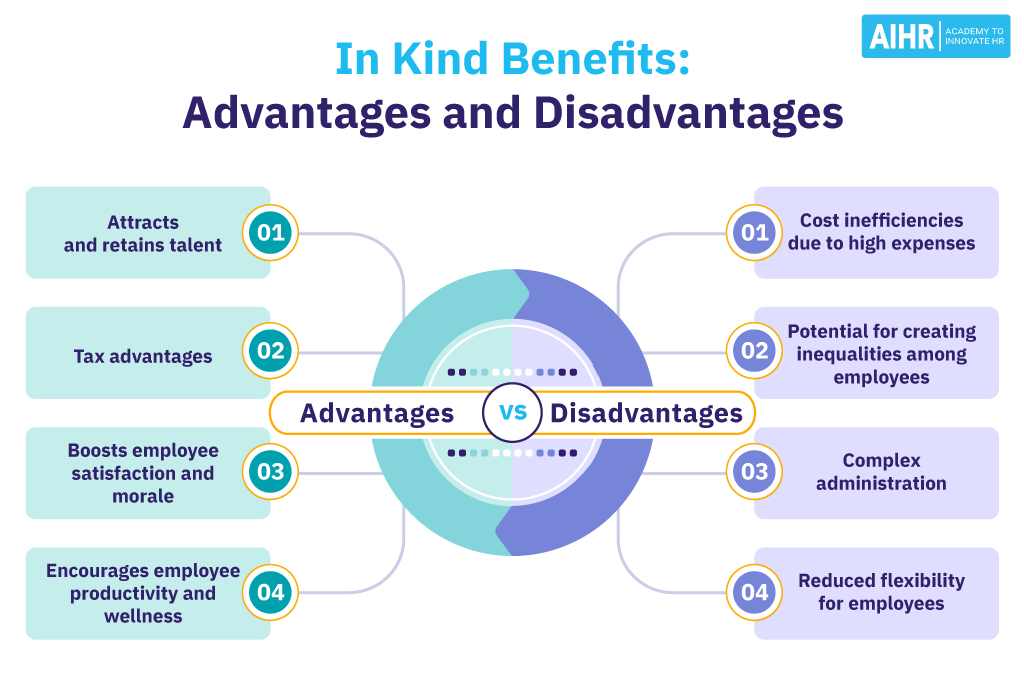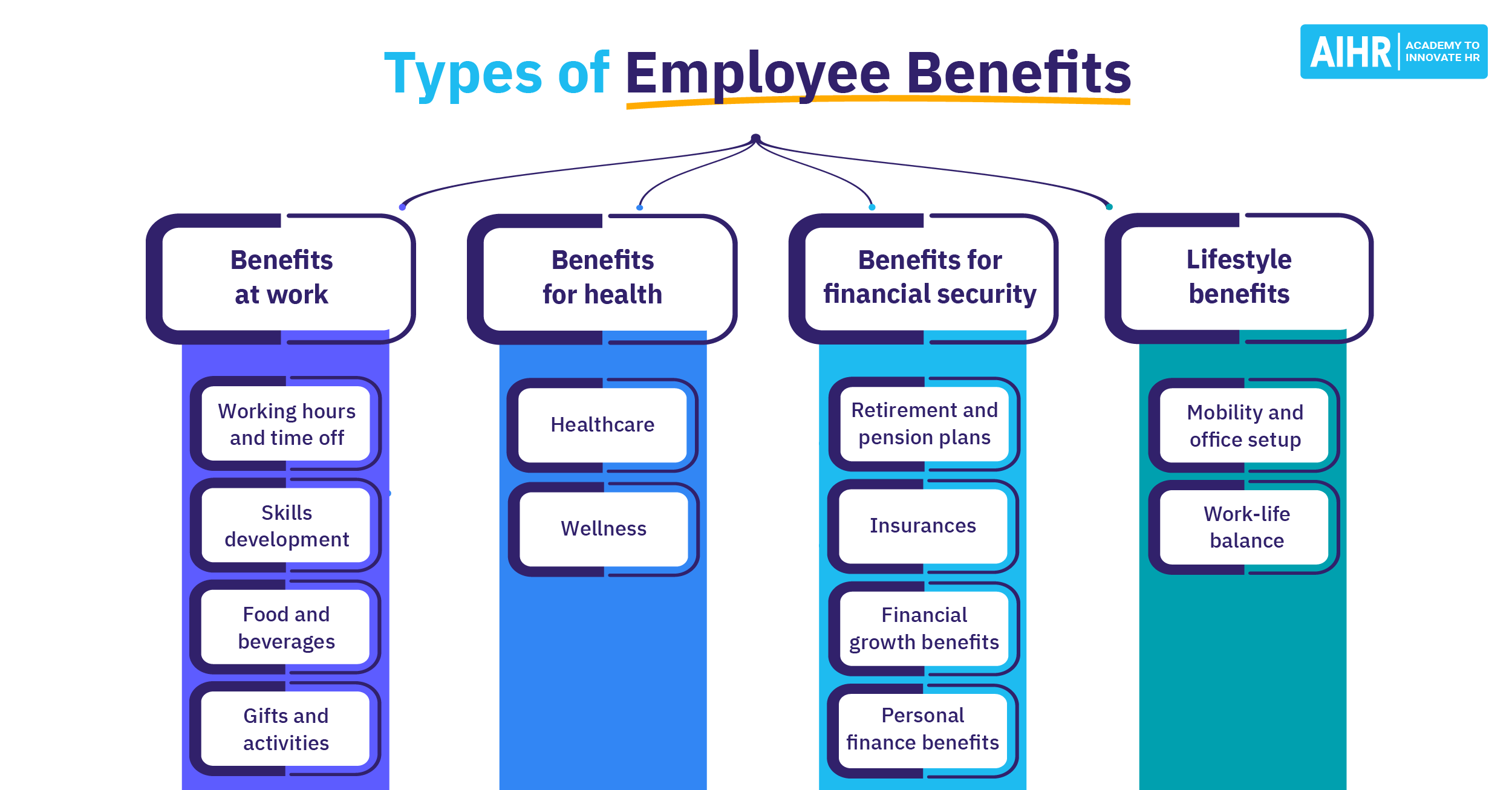In Kind Benefits
What are in-kind benefits?
In-kind benefits, also referred to as benefits in kind (BIK), are non-monetary compensation provided to employees. These benefits are part of an employee’s total compensation package but do not involve direct cash payments. Examples of in-kind benefits include services like health insurance, retirement plans, childcare assistance, and flexible working arrangements.
In-kind benefits examples
Examples of these benefits include:
- Healthcare benefits: These typically cover medical, dental, and vision expenses. An employer might offer a comprehensive health insurance plan that includes preventive care, surgeries, hospital stays, and even mental health services. For example, a company might cover 80% of medical costs, with employees paying the remainder.
- Meals and refreshments: Many companies provide free or subsidized meals and refreshments. This can range from fully catered cafeterias to snack rooms stocked with healthy options. For instance, a tech startup might offer a free gourmet lunch daily or have a kitchen filled with snacks and drinks for employees.
- Transportation benefits: This could include subsidies for public transportation, parking allowances, or even shuttle services from key locations to the office. A large corporation might offer metro card reimbursements or have a fleet of buses that pick up employees from various locations.
- Retirement benefits: Common retirement benefits include contributions to pension plans or 401(k) accounts. An employer might match employee contributions up to a certain percentage, helping build their retirement savings. For example, a company might offer a 50% match for the first 6% of salary an employee contributes to their 401(k).
- Accommodation: Some employers provide housing or housing allowances, especially in industries like mining or oil and gas, where employees need to be close to remote work sites. An example would be a company providing on-site living quarters for employees working in remote areas.
- Childcare assistance: This can include on-site childcare facilities or subsidies to offset the cost of external childcare services. A large corporation might operate a daycare center at the workplace or partner with local providers for discounted rates.
Are in-kind benefits taxable?
In-kind benefits can be taxable, but the specifics depend on the type and value of the benefits and the tax laws of the particular country or region.
The taxability of these benefits is governed by the Internal Revenue Service (IRS) regulations, and it’s important for both employers and employees to be aware of these rules to ensure compliance and accurate reporting.
Let’s explore the difference between taxable and non-taxable in-kind benefits:
1. Taxable in-kind benefits
Taxable in-kind benefits are considered part of an employee’s taxable income. These benefits provide personal advantages to employees and thus are subject to income tax and other employment taxes. The valuation of these benefits is typically based on their fair market value.
Common examples of taxable in-kind benefits include:
- Personal use of a company car
- Housing provided by the employer
- Gym memberships or tickets to events.
2. Non-taxable in-kind benefits
Non-taxable in-kind benefits are excluded from an employee’s taxable income. These benefits are often considered necessary for the performance of a job or are so minimal in value that taxing them is unreasonable or administratively impractical.
Examples of non-taxable in-kind benefits include:
- Health insurance
- Educational assistance
- Employee discounts (on goods or services).
Advantages and disadvantages of in-kind benefits
Here are some of the advantages and disadvantages of offering these benefits:
| Advantages | Disadvantages |
|---|---|
| Cost inefficiencies: Providing in-kind benefits can sometimes be more costly for employers, especially if the benefits are specialized or require ongoing maintenance and support. | Cost inefficiencies: Providing in kind benefits can sometimes be more costly for employers, especially if the benefits are specialized or require ongoing maintenance and support. |
| Boosts employee satisfaction and morale: In-kind benefits can significantly elevate morale and job satisfaction. They often address specific employee needs, making employees feel valued and cared for. | Potential for creating inequality: If not managed carefully, in-kind benefits can create perceived or actual disparities among employees, especially if some benefits are only available to certain groups or levels within the organization. |
| Complex administration: Managing in-kind benefits often requires more administrative effort than cash benefits. This includes tracking usage, maintaining inventory, and ensuring equitable employee distribution. | Complex administration: Managing in kind benefits often requires more administrative effort than cash benefits. This includes tracking usage, maintaining inventory, and ensuring equitable employee distribution. |
| Encourages employee productivity and wellness: Benefits like gym memberships, wellness programs, or ergonomic office furniture can lead to healthier, more energetic employees, which in turn can boost productivity. | Reduced flexibility for employees: Some employees might prefer a higher salary over in-kind benefits, especially if the benefits provided are not aligned with their personal needs or lifestyle. |

What should HR consider when including in-kind benefits in compensation?
Before including these benefits in employee’s compensation packages, HR should take several important factors into account:
- Legal and tax implications: It’s essential to understand the legal and tax implications of offering certain in-kind benefits. Some benefits may be taxable for the employee or might have compliance requirements under labor laws.
- Ease of administration: The logistical aspect of offering and managing these benefits should be manageable and not overly burdensome for the HR department.
- Employees needs and preferences: Tailoring in-kind benefits to the needs and preferences of the current workforce is crucial. This may involve conducting surveys or focus groups to determine which benefits are most valued by employees.
- Cost and budget implications: It’s important to evaluate the financial impact of offering these benefits, including initial setup costs, ongoing expenses, and any potential cost savings compared to other forms of compensation.
- Competitiveness in the market: The benefits package should be competitive to attract and retain talent. Researching what similar companies in the industry offer can provide valuable insights.
FAQ
In-kind benefits are non-monetary compensations provided to employees, like goods and services such as free meals, company cars, health insurance, gym memberships, childcare assistance, or educational subsidies. They are perks or fringe benefits that enhance an employee’s salary package, offering practical value and often contributing to job satisfaction and work-life balance.
The most common in-kind benefits include health insurance, retirement plans like 401(k) or pensions, company-provided vehicles or transportation allowances, educational assistance or tuition reimbursement, and flexible working arrangements such as remote work options or flexible hours. These benefits are designed to support the overall wellbeing and satisfaction of employees.







